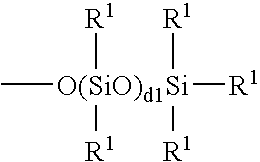Paper treating agent comprising a silicone composition
- Summary
- Abstract
- Description
- Claims
- Application Information
AI Technical Summary
Benefits of technology
Problems solved by technology
Method used
Image
Examples
preparation example 1
[0067] 100 parts by mass of Metholose SM-25, trademark, (hereinafter referred to as cl) from Shin-Etsu Chemical. Co., Ltd., methoxy-substituted cellulose ether with a substitution degree of 2, whose aqueous 2% solution has a viscosity of 20 mPa.s at 20 degrees C., was mixed with 900 parts by mass of water and the mixture was stirred until a uniform 10% solution in water was obtained.
preparation example 2
[0068] 100 parts by mass of Metholose SM-3, trademark (hereinafter referred to as c2) from Shin-Etsu Chemical. Co., Ltd., methoxy-substituted cellulose ether with a substitution degree of 2, whose aqueous 2% solution has a viscosity of 3 mPa. s at 20 degrees C., was mixed with 900 parts by mass of water and the mixture was stirred until a uniform 10% solution in water was obtained.
preparation example 3
[0069] 100 parts by mass of Metholose SM-100, trademark (hereinafter referred to as c3) from Shin-Etsu Chemical. Co., Ltd., methoxy-substituted cellulose ether with a substitution degree of 2, whose aqueous 2% solution has a viscosity of 80 mPa. s at 20 degrees C., was mixed with 900 parts by mass of water and the mixture was stirred until a uniform 10% solution in water was obtained.
PUM
| Property | Measurement | Unit |
|---|---|---|
| Fraction | aaaaa | aaaaa |
| Percent by mass | aaaaa | aaaaa |
| Percent by mass | aaaaa | aaaaa |
Abstract
Description
Claims
Application Information
 Login to View More
Login to View More - R&D
- Intellectual Property
- Life Sciences
- Materials
- Tech Scout
- Unparalleled Data Quality
- Higher Quality Content
- 60% Fewer Hallucinations
Browse by: Latest US Patents, China's latest patents, Technical Efficacy Thesaurus, Application Domain, Technology Topic, Popular Technical Reports.
© 2025 PatSnap. All rights reserved.Legal|Privacy policy|Modern Slavery Act Transparency Statement|Sitemap|About US| Contact US: help@patsnap.com



